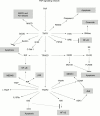Tumour necrosis factors receptor associated signalling molecules and their role in activation of apoptosis, JNK and NF-kappaB
- PMID: 11053079
- PMCID: PMC1766635
- DOI: 10.1136/ard.59.suppl_1.i6
Tumour necrosis factors receptor associated signalling molecules and their role in activation of apoptosis, JNK and NF-kappaB
Abstract
Tumour necrosis factor (TNF) is a pleiotropic cytokine that mediates apoptosis, cell proliferation, immunomodulation, inflammation, viral replication, allergy, arthritis, septic shock, insulin resistance, autoimmune diseases, and other pathological conditions. TNF transduces these cellular responses through two distinct receptors: type I, which are expressed on all cell types, and type II, which are expressed only on cells of the immune system and endothelial cells. At the cellular level, these receptors activate the pathways leading to the activation of transcription factors NF-kappaB and AP-1, apoptosis and proliferation, and mitogen activated protein kinases. None of these receptors exhibit any enzymatic activity but the signals are transmitted through the recruitment of more than a dozen different signalling proteins, which together form signalling cascades. Inhibitors of TNF signalling have therapeutic value as indicated by the approval of the soluble TNF receptors and anti-TNF antibodies for rheumatoid arthritis and for inflammatory bowl disease.
Figures






References
Publication types
MeSH terms
Substances
LinkOut - more resources
Full Text Sources
Other Literature Sources
Research Materials

